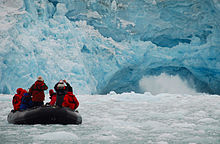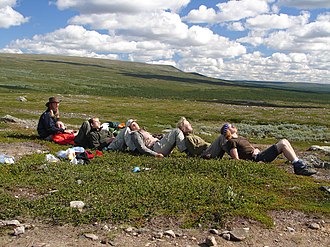Ecotourism
Ecotourism (also: natural tourism) is a form of tourism that takes special account of the interests of the environment and the local population .
definition
In particular, however, there are considerable delimitation difficulties. For some, it means traveling to relatively unspoiled areas without harming the environment or the local population. However, air travel to near-natural areas (e.g. national parks ) is also often made in order to practice ecotourism there, which is generally not ecologically sustainable .
A stricter definition of ecotourism according to The International Ecotourism Society (TIES): Ecotourism is a responsible form of travel to near-natural areas that protects the environment, contributes to the well-being of the local population and includes nature mediation and education . (" Responsible travel to natural areas that conserves the environment, sustains the well-being of the local people, and involves interpretation and education. ")
The Federal Agency for Nature Conservation describes ecotourism as follows: Ecological tourism is the further development of the concept of environmentally friendly or environmentally friendly tourism. Since, in German usage, environmental compatibility tends to be limited to the human environment from an anthropocentric perspective, although an intact natural balance and an environment that is also appropriate for wild plants and animals is required more comprehensively, the perspective in ecotourism has been expanded to include ecosystem connections. The goal, especially from the scientific and NGO side, is "ecologically responsible tourism".
The word ecotourism mostly refers less to arrival and departure, but (especially internationally) to environmentally friendly behavior at the holiday destination.
Regarding the definition of nature tourism according to GTZ (Ludwig Ellenberg): "It is a special demand segment, which is characterized by the fact that nature-related activities are carried out in attractive natural landscapes, preferably in protected areas."
These include:
- Science tourism
- Wildlife viewing
- Nature photography
- Consumption activities (fishing, hunting)
- Sports and Adventure Tourism

In order not only to pursue pure nature tourism , but also ecotourism, the activity should always protect nature in a sustainable way and make a contribution to the local population. With regard to the consumptive activities, it is important to consider how high the return per traveler is compared to other activities (hunting ↔ photo safari). A question that will probably always trigger contradictions.
The now defunct nature conservation organization PAN Parks Foundation has developed a concept to combine ecotourism, local economic development and nature conservation in European protected areas with a wilderness character . The concept is being continued by the European Wilderness Society .
In Spanish usage, ecoturismo, on the other hand, can mean a mere excursion into the countryside . In Ecuador , the term is used as a marketing strategy to offer potential customers another reason to buy a nature tourism trip, which actually has little to do with eco-friendly travel.
Compared to ecotourism, sustainable tourism can take place not only in almost untouched areas, but also in cities.
history
The term ecotourism originated in the USA in the 1960s : Ecotourism is responsible travel to natural areas that conserves the environment and sustains the well being of local people (The Ecotourism Society 1991). In 1990 Namibia was one of the first countries in the world to grant constitutional protection to environmental protection and has since coordinated ecological tourism through the Ministry of Environment and Tourism created for this purpose .
In 1992 the topic of “sustainability” moved into the focus of the United Nations: During the Rio Conference, the international community agreed on the “sustainability principle”, which should also play a role in tourism. Specifically, guest satisfaction and the strengthening of the regional economy should go hand in hand with nature conservation and the improvement of the quality of life for the locals. In Germany, it is the task of the Federal Agency for Nature Conservation to implement these demands through specific projects.
Examples
Ecotourism has become a market segment in its own right and is spread around the world. Two examples in Africa that the WWF rates positively are the Kavango-Zambezi (KAZA) and Virunga National Park.
criticism

Most ecotourism is about trips to nature. In doing so, it is often damaged by excessive use. For example, entire forests were cut down in Nepal in order to provide “ trekkers ” with wood. Often "eco- tourists " travel to areas that are home to many rare plants and animals . This may endanger them.
Critics of ecotourism point out that areas that are opened up for ecotourism can soon lead to extensive developments including infrastructure expansion and ultimately mass tourism with all its environmentally damaging effects. " Developing countries " with their rather low environmental protection requirements are particularly at risk , since they are particularly attractive for foreign tourism companies that want to make high profits with little capital investment. In addition, the journey - often with the highly polluting aircraft - is disregarded.
Incidentally, ecotourism itself also has a negative impact on the target area. The idea that tourism should help finance the protection of nature makes sense, but it often doesn't work out: For example, trips to the spawning areas of sea turtles , which are supposed to finance their protection, cause unforeseeable and perhaps not obvious impairments to the ecosystem concerned with himself. One example of this is the pollution of the turtle's habitat by hotel sewage, which in developing countries is often discharged into the sea without being treated. The income from diving tourism in Kenya does not stop the reef dying ; The ecological impact of tourism beyond the park fences and on the way to the park gates (speed boats, hotel waste water) must be fully taken into account. A nature-friendly management of the increasing number of visitors also costs money that the coffers of many park administrations do not give away.
Problems also arise in the cultural sector. The indigenous peoples , around 300 million people who inhabit an estimated 90 percent of the areas that are home to the highest biodiversity and the rarest species in the world, are particularly affected . In the course of ecologically motivated tourism projects, for example, they were driven out of their traditional habitat by barring them from entering the protected areas through fences. Since their land rights are legally very unstable, tourism often represents a real threat to their livelihoods. A similar situation can also be found in Kenya's Samburu National Park . The chairman of the Kenya Pastoralist Forum complains that even in the dry season the herders are denied access to the water inside the park at gunpoint. In Bangladesh, 1000 families have been worried about access to their forests since the plan for an "eco-park" became known and the forest and environmental authorities declared the residents' settlements illegal. The residents of the historical site of Kuelap in Peru are to be driven from their cultivation areas and their cultural heritage in order to make way for a tourist project. The national cultural authority does not refrain from threats and violent attacks on the farmers.
Others
The UN chose 2002 as the International Year of Ecotourism.
See also
literature
- L. Ellenberg among others: Ecotourism: Travel between economy and ecology. Heidelberg et al. 1997.
- Ulrich Grober : About hiking. New ways to an old art. Zweausendeins Verlag, Frankfurt 2006, ISBN 3-86150-772-2 .
- K. Lindberg et al: Ecotourism, A Guide For Planners and Managers. Volume 1, North Bennington 1993. (English)
- K. Lindberg et al: Ecotourism, A Guide For Planners and Managers. Volume 2, North Bennington 1998. (English)
- Federal Ministry for Economic Cooperation and Development (Ed.): Ecotourism as an instrument of nature conservation ?: Options for increasing the attractiveness of nature conservation projects . Ecotourism working group, Munich et al. 1995.
- G. Danielli, R. Sonderegger: Compact knowledge of nature tourism. Rüegger Verlag, Zurich 2009, ISBN 978-3-7253-0924-5 .
- D. Siegrist, M. Stremlow: Longing - Experience - Landscape. Close to nature tourism in parks and UNESCO areas. Zurich 2009, ISBN 978-3-85869-393-8 .
Web links
- The International Ecotourism Society: www.ecotourism.org
- respect - Institute for Integrative Tourism and Development: www.respect.at
- Federal Agency for Nature Conservation: www.bfn.de
Individual evidence
- ↑ What Is Ecotourism? The International Ecotourism Society, 2015, accessed March 22, 2020 .
- ↑ Ecotourism: Terms and Definitions. Federal Agency for Nature Conservation, accessed on March 22, 2020 .
- ↑ Brit Reichelt-Zolho, John Kirchgatter: Ecotourism in Africa. on: dandc.eu
